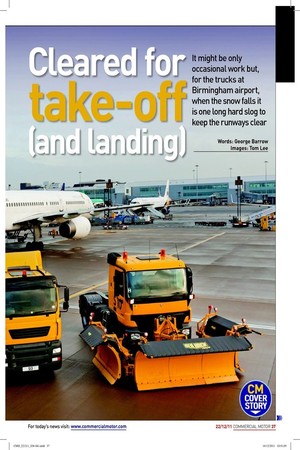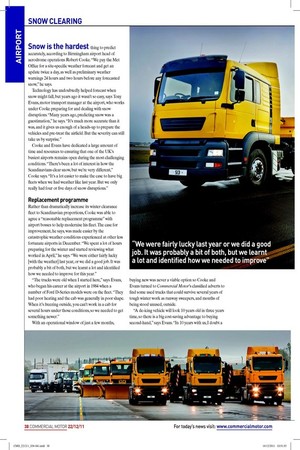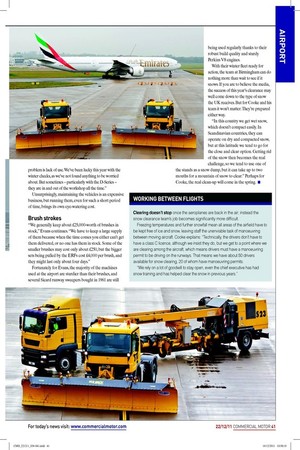Cleared for
Page 31

Page 32

Page 33

Page 34

Page 35

If you've noticed an error in this article please click here to report it so we can fix it.
ake-o
(and landing)
Words: George Barrow Images: Tom Lee Snow is the hardest thing to predict accurately, according to Birmingham airport head of aerodrome operations Robert Cooke. “We pay the Met Ofice for a site-speciic weather forecast and get an update twice a day, as well as preliminary weather warnings 24 hours and two hours before any forecasted snow,” he says.
Technology has undoubtedly helped forecast when snow might fall, but years ago it wasn’t so easy, says Tony Evans, motor transport manager at the airport, who works under Cooke preparing for and dealing with snow disruptions. “Many years ago, predicting snow was a guestimation,” he says. “It’s much more accurate than it was, and it gives us enough of a heads-up to prepare the vehicles and pre-treat the airield. But the severity can still take us by surprise.” Cooke and Evans have dedicated a large amount of time and resources to ensuring that one of the UK’s busiest airports remains open during the most challenging conditions. “There’s been a lot of interest in how the Scandinavians clear snow, but we’re very different,” Cooke says. “It’s a lot easier to make the case to have big leets when we had weather like last year. But we only really had four or ive days of snow disruptions.”
Replacement programme
Rather than dramatically increase its winter clearance leet to Scandinavian proportions, Cooke was able to agree a “reasonable replacement programme” with airport bosses to help modernise his leet. The case for improvement, he says, was made easier by the catastrophic weather conditions experienced at other less fortunate airports in December. “We spent a lot of hours preparing for the winter and started reviewing what worked in April,” he says. “We were either fairly lucky [with the weather] last year, or we did a good job. It was probably a bit of both, but we learnt a lot and identiied how we needed to improve for this year.” “The trucks were old when I started here,” says Evans, who began his career at the airport in 1984 when a number of Ford D-Series models were on the leet. “They had poor heating and the cab was generally in poor shape. When it’s freezing outside, you can’t work in a cab for several hours under those conditions, so we needed to get something newer.” With an operational window of just a few months,
buying new was never a viable option so Cooke and Evans turned to Commercial Motor’s classiied adverts to ind some used trucks that could survive several years of tough winter work as runway sweepers, and months of being stood unused, outside.
“A de-icing vehicle will look 10 years old in three years time, so there is a big cost-saving advantage to buying second-hand,” says Evans. “In 10 years with us, I doubt a truck would do 5,000km. That’s why we focus on checking the engine for signs of oil leaks and the body for corrosion. We decided to replace our old tractors with ERFs that had between 400,000km and 500,000km on the clock. And having seven ERFs, all the same, makes maintenance and parts a lot easier. We’ve always had a mixed leet, so it is nice to standardise our leet where we can, especially as we look after nearly 200 pieces of kit.”
Presentable fleet
Despite being trucks that many hauliers would turn their noses up at, the winter leet still had to look presentable, and even though the vehicles were bought for use on the airield, Cooke was adamant they must be road-legal, not least to satisfy their own safety standards.
“Our vehicles don’t go out on the road at the moment, but they still have to be able to. We test them to the same standards that VOSA would, but because of the media attention a weather incident gets we are also concerned about our vehicle’s overall appearance. We’re applying for a restricted O-licence and, although we’re not doing transport as a business, it will allow us to collect our own de-icer if we need to.” While council salt and grit supplies often run low during a cold snap, running low airside could be disastrous for Birmingham’s clear-up operation. Regular road salt can’t be used on the airield because aeroplanes are made of aluminium, so a costly chemical de-icer has to be used that, in bulk, costs more than £1 per litre. It’s a necessary but expensive cost of snow clearance that, over the past three winters, has cost between £500,000 and £700,000 a year, with an average of 50,000 litres used every day.
Yet chemicals alone won’t clear the snow completely, and are frequently used just to maintain the level of snow to make clearing with machines easier.
Like the well-drilled teams of ball boys and girls at Wimbledon waiting to pull the tennis court covers on as the rain begins to fall, Cooke and his team – made up of employees, contractors and volunteers – can be ready to begin clearance operations on the runway within two minutes of the airport being closed. From that moment, and depending on the snowfall, the runway can often be reopened within 60 to 90 minutes thanks to the array of brushing and blowing equipment used in the clean-up.
Last year, Birmingham’s longest closure was for just seven hours, but having served for nearly 15 years in operational roles at Stanstead, Doncaster and now Birmingham airport, Cooke is aware that opening runways too early can lead to further dificulties.
Perfect balance
“You have to have a balance of cleaning the runways and cleaning the stands. Not opening too soon, leaving aeroplanes with nowhere to go once they’ve landed is the key. Unfortunately, the stands are the most dificult bits to clear, as they usually have aeroplanes on them. After we’re sure its safe for aeroplanes to land, it then becomes a question of maintaining the approaches.” As capable as the team is at performing their job, clearing runways of snow is still a relatively new task at Birmingham. “Prior to the past three years we hadn’t had any serious snow for 10 years,” Evans says. “Countries that are geared up for snow still have disruptions, but a lot of countries that are far better prepared than us still struggle. The only difference is that it doesn’t make news in our country if Germany is having problems.” As each sweeper being towed by an ERF costs more than £250,000, it is not surprising that many UK airports struggle to invest in such costly seasonal equipment. But even with just one runway to maintain, clearing the 2.6km stretch at Birmingham requires a substantial amount of apparatus.
In addition to the seven ERFs, the airport owns three 4x4 Mercedes-Benz Actros models, used to push two 7.2m ploughs, and a 6m Ramp Hog box plough that can push more than 10 tonnes of snow off the runway. There are also six Massey Ferguson and two John Deere tractors, used for brushing, two snow cutters, two road gritters with ploughs, and three de-icing rigs, the largest of which has an 8,000-litre capacity and 24m span – enough to cover half the width of the runway.
Extra plant equipment has to be brought in from local suppliers to help shift the mountains of snow that accumulate during a busy clearance operation, adding further costs and complexity to the clear-up.
Being able to bring in this equipment on hire is probably a blessing for Evans, who oversees the workshop and maintenance of the airport leet and its snow vehicles.
“We’ve got more than 40 vehicles just on snow clearance, which require general maintenance throughout the year,” Evans says. “They suffer from the weather, but the main problem is lack of use. We’ve been lucky this year with the winter checks, as we’ve not found anything to be worried about. But sometimes – particularly with the D-Series – they are in and out of the workshop all the time.” Unsurprisingly, maintaining the vehicles is an expensive business, but running them, even for such a short period of time, brings its own eye-watering cost.
Brush strokes
“We generally keep about £25,000-worth of brushes in stock,” Evans continues. “We have to keep a large supply of them because when the time comes you either can’t get them delivered, or no one has them in stock. Some of the smaller brushes may cost only about £250, but the bigger sets being pulled by the ERFs cost £4,000 per brush, and they might last only about four days.” Fortunately for Evans, the majority of the machines used at the airport are sturdier than their brushes, and several Sicard runway sweepers bought in 1961 are still being used regularly thanks to their robust build quality and sturdy Perkins V8 engines.
With their winter leet ready for action, the team at Birmingham can do nothing more than wait to see if it snows. If you are to believe the media, the success of this year’s clearance may well come down to the type of snow the UK receives. But for Cooke and his team it won’t matter. They’re prepared either way.
“In this country we get wet snow, which doesn’t compact easily. In Scandinavian countries, they can operate on dry and compacted snow, but at this latitude we tend to go for the close and clear option. Getting rid of the snow then becomes the real
challenge, so we tend to use one of the stands as a snow dump, but it can take up to two months for a mountain of snow to clear.” Perhaps for Cooke, the real clean-up will come in the spring. ■













































